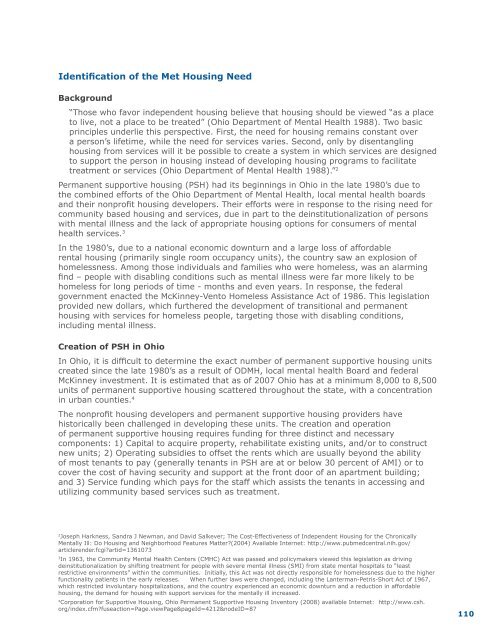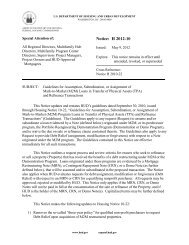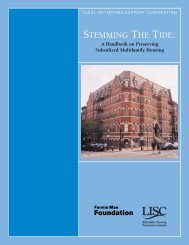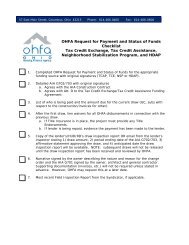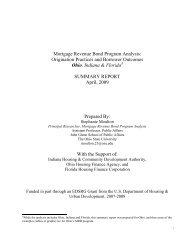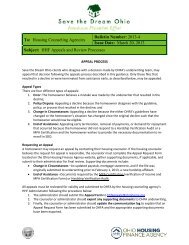OHFA Annual Plan - Ohio Housing Finance Agency
OHFA Annual Plan - Ohio Housing Finance Agency
OHFA Annual Plan - Ohio Housing Finance Agency
You also want an ePaper? Increase the reach of your titles
YUMPU automatically turns print PDFs into web optimized ePapers that Google loves.
Identification of the Met <strong>Housing</strong> NeedBackground“Those who favor independent housing believe that housing should be viewed “as a placeto live, not a place to be treated” (<strong>Ohio</strong> Department of Mental Health 1988). Two basicprinciples underlie this perspective. First, the need for housing remains constant overa person’s lifetime, while the need for services varies. Second, only by disentanglinghousing from services will it be possible to create a system in which services are designedto support the person in housing instead of developing housing programs to facilitatetreatment or services (<strong>Ohio</strong> Department of Mental Health 1988).” 2Permanent supportive housing (PSH) had its beginnings in <strong>Ohio</strong> in the late 1980’s due tothe combined efforts of the <strong>Ohio</strong> Department of Mental Health, local mental health boardsand their nonprofit housing developers. Their efforts were in response to the rising need forcommunity based housing and services, due in part to the deinstitutionalization of personswith mental illness and the lack of appropriate housing options for consumers of mentalhealth services. 3In the 1980’s, due to a national economic downturn and a large loss of affordablerental housing (primarily single room occupancy units), the country saw an explosion ofhomelessness. Among those individuals and families who were homeless, was an alarmingfind – people with disabling conditions such as mental illness were far more likely to behomeless for long periods of time - months and even years. In response, the federalgovernment enacted the McKinney-Vento Homeless Assistance Act of 1986. This legislationprovided new dollars, which furthered the development of transitional and permanenthousing with services for homeless people, targeting those with disabling conditions,including mental illness.Creation of PSH in <strong>Ohio</strong>In <strong>Ohio</strong>, it is difficult to determine the exact number of permanent supportive housing unitscreated since the late 1980’s as a result of ODMH, local mental health Board and federalMcKinney investment. It is estimated that as of 2007 <strong>Ohio</strong> has at a minimum 8,000 to 8,500units of permanent supportive housing scattered throughout the state, with a concentrationin urban counties. 4The nonprofit housing developers and permanent supportive housing providers havehistorically been challenged in developing these units. The creation and operationof permanent supportive housing requires funding for three distinct and necessarycomponents: 1) Capital to acquire property, rehabilitate existing units, and/or to constructnew units; 2) Operating subsidies to offset the rents which are usually beyond the abilityof most tenants to pay (generally tenants in PSH are at or below 30 percent of AMI) or tocover the cost of having security and support at the front door of an apartment building;and 3) Service funding which pays for the staff which assists the tenants in accessing andutilizing community based services such as treatment.2Joseph Harkness, Sandra J Newman, and David Salkever; The Cost-Effectiveness of Independent <strong>Housing</strong> for the ChronicallyMentally Ill: Do <strong>Housing</strong> and Neighborhood Features Matter?(2004) Available Internet: http://www.pubmedcentral.nih.gov/articlerender.fcgi?artid=13610733In 1963, the Community Mental Health Centers (CMHC) Act was passed and policymakers viewed this legislation as drivingdeinstitutionalization by shifting treatment for people with severe mental illness (SMI) from state mental hospitals to “leastrestrictive environments” within the communities. Initially, this Act was not directly responsible for homelessness due to the higherfunctionality patients in the early releases. When further laws were changed, including the Lanterman-Petris-Short Act of 1967,which restricted involuntary hospitalizations, and the country experienced an economic downturn and a reduction in affordablehousing, the demand for housing with support services for the mentally ill increased.4Corporation for Supportive <strong>Housing</strong>, <strong>Ohio</strong> Permanent Supportive <strong>Housing</strong> Inventory (2008) available Internet: http://www.csh.org/index.cfm?fuseaction=Page.viewPage&pageId=4212&nodeID=87110


